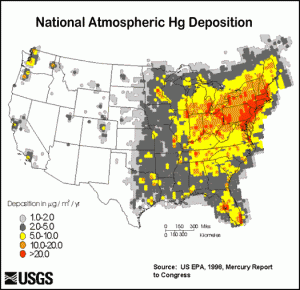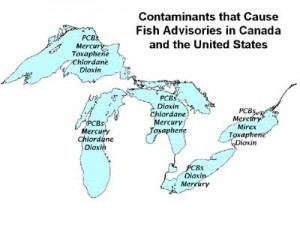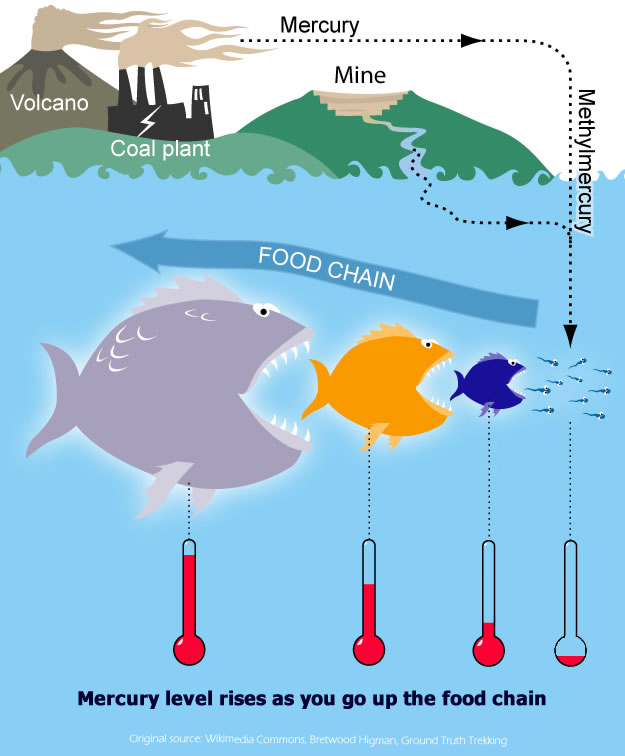
Of all the toxins, parasites, bacteria, and bugs that can affect seafood, the most ubiquitous and dangerous is methyl mercury. This compound continues to threaten fish as a healthy and sustainable food. The main sources of mercury levels in seafood are from coal-fired power plants.

Mercury is an inorganic element of the earth’s crust comprising about 0.5 parts per million. Coal burning and incinerators are responsible for the release of about half of the inorganic mercury into the atmosphere. Coal “aficionados” will point out the low levels of mercury in the coal, however the large amount of coal used in power plants overcomes even the small amount of the toxin. “Clean coal” promises that mercury levels will be much lower but the technology has not been not widely implemented.
The mercury is effectively scavenged out of the air by the forests, and as the wood or leaves decay the mercury finds its way into the water catchments, wetlands, creeks, streams, rivers, lakes, and ultimately the ocean. Because of the effective nature of forests in scavenging inorganic mercury from the atmosphere, forest fires yield high levels of mercury into the environment that ultimately find their way into food sources.
This inorganic mercury is changed to methylated mercury (MeHg) by the bacteria in the process of recycling the organic matter from the trees. As the leaves fall, they begin decay that recycles their material back to earth. The multiple types of bacteria that potentiate the change to methyl mercury and are found in water, from fresh to saltwater.
The food chain goes from the bacteria into the algae (phytobenthos). It is in these algae that the water quality can be measured, as in Europe where the periphyton are used to monitor mercury content. These algae and other phytobenthos find there way into the filter feeding creatures that are then preyed up on by fish. The concentration of methyl mercury rises as it goes up the food chain.
The variability of methyl mercury in fish is large, depending upon the consumption of the prey and growth rates of the fish. Rapidly growing fish can have reduced concentration of the toxin secondary to dilution.
In the United States even the most pristine lakes are affected, with the forests surrounding them being effective scavengers for environmental mercury. While clearly lakes and areas next to industrial sources of mercury have high levels, the levels of the most native lakes have been affected. Over 3,000 lakes in the United States have been closed to fishing because of high mercury levels.

Many lakes have not been tested, at risk in particular are those lakes within a few thousand miles of coal burning power plants, cement manufacturing plants, gold mines, waste burning facilities, or large combustion boilers. The unwary sports fisherman thinking he is catching healthy fish in a pristine lake may be inadvertently poisoning his family with a mercury-laden catch.

Restaurant and home chefs need be wary of wild caught fish in areas where the mercury levels have not been tested, and should consider submitting samples of a fish to a laboratory but knowing that mercury levels in fish vary widely depending upon how fast the fish has grown.

Mercury Toxicity -How it Makes You Sick
Methyl mercury easily binds to the amino acids cysteine, and the complex, methylmercuric-cystein appears as the essential amino acid methionine, an essential amino acid that is actively transported into the bloodstream. The body does not recognize this as different and this complex is incorporated across many proteinst, and easily crosses into the blood brain barrier where it does its major damage.
The mercury interferes with DNA transcription and protein synthesis – the methyl mercury complex is placed into a protein, but forms an unstable and the intended protein molecule is then degraded by the cell. In particular a developing brain is susceptible to this damage. Methyl mercury poisoning has been linked to cerebral palsy as well as developmental delays in cognitive function of newborns to children under the age of 12. This is the reasoning behind the warnings to pregnant or potentially pregnant women, and children under the age of 12, to avoid fish that are known to be high in mercury content.
Mercury is also reactive with selenium, an essential micronutrient. Selenium based enzymes are responsible for reversing the oxidative damage done to the brain and endocrine organs. This also explains the neurological symptoms in the brain as well as the peripheral nervous system, and the interference with the adrenal access, thus patients acting as if they have constant high levels of epinephrine and cortisol.
Adults are not spared mercury symptoms. Food supplies have been contaminated with high levels of methyl mercury: in Iraq in the 1960’s and 1970’s wheat was treated with methyl mercury and the grain fed to animals that were then consumed. Industrial waste in Japan, in two areas, resulted in poisoning of the population. The result was primarily neurologic symptoms, numbness, loss of coordination, difficulty with speech, visual field deficits and blindness, hearing loss, and death were the result of acute toxicity.
Chronic long-term toxicity has been linked to heart disease but not to cancer. It is the chronic effects of mercury poisoning that most individuals will suffer. These include peripheral nerve sensations of pins-and-needles (paresthesia), typically in the hands and feet, and around the mouth. In addition, tremors, cognitive changes, and vision changes can be noted. Skin can also present with itching, or burning, or pain in those areas. Pink cheeks, fingertips and toes are noted, as well as an increase in shedding of the skin. There may also be sweating, tachycardia (fast heart beat), increased salivation, as well as high blood pressure which leads one to rule out adenoma tumors.
The difficulty with chronic mercury poisoning is there is no reliable test to determine total mercury levels in a human. Mercury is widely distributed throughout the proteins of the body, and not in a uniform equilibrium with blood or urine. Methyl mercury concentrates in the brain, liver, kidneys, as well as the placenta and fetus. There is no blood or urine test that provides a level where toxic symptoms won’t occur. Hair analysis only shows the acute phase but not what may be left inside. Placing a human into a cold room and allowing the mercury to go to the feet, and measuring that level has yet to be tried – much like a thermometer.
Mercury’s half-life in the body is estimated between 50 and 70 days. If toxicity is suspected there are chelating agents that facilitate removal. The liver is the primary mechanism of excretion, sending mercury on the way through the biliary system, where methyl mercury has been altered such that it won’t absorb again and will be excreted in stool.
SAFE TO EAT DAILY: Wild Alaska Salmon, oysters, pollock , tilapia (Alaskan halibut)
SAFE TO EAT OFTEN: Arctic char, Atlantic mackerel, herring, rainbow trout, sardines, canned light tuna or speciality US tuna
SAFE TO EAT SOMETIMES: Catfish, halibut (note below), jackfish, kingfish, perch snapper, commercial canned albacore
NOTE THAT Alaskan Halibut is extensively tested and mercury levels are very low and these fish are able to be eaten about 4 times a week for pregnant mothers and children under 12. Others can have unlimited amounts. Non-Alaskan halibut should be eaten no more than twice a week.
AVOID (or eat rarely): Barracuda, escolar, marlin, orange roughy, shark, tuna steak
Mercury is biomagnified through the food chain and the highest concentrations of mercury being found in long-living predatory fish that are at the top of the food chain. Highest levels of mercury are found in sharks, swordfish, tilefish, and king mackerel. Lowest levels of mercury are found in salmon, herring, sardines, Arctic char, Atlantic Mackerel, and rainbow trout.

Tuna and Mercury
Tuna represents the major fish consumed in the United States and as a source of mercury the content varies. Pacific Albacore have low levels of mercury compared to albacore caught from other areas. The larger species of tuna, such as the Bluefin have the highest concentrations of mercury, but have been fished into near extinction. Most tuna fish in cans is a combination of multiple tunas that are tested collectively for their mercury content. Where these are caught is Skipjack, yellowfin, and tongol tuna have the lowest concentrations of mercury with albacore being intermediate.

Specialty US canned tuna that is frequently tested for mercury is safe to eat. This brand, Oregon’s Choice, submits their samples for testing frequently
Responsible tuna fish will periodically send their tuna in for mercury testing, such as Oregon’s Choice Tuna, where the mercury levels are nearly undetectable and quite safe.
